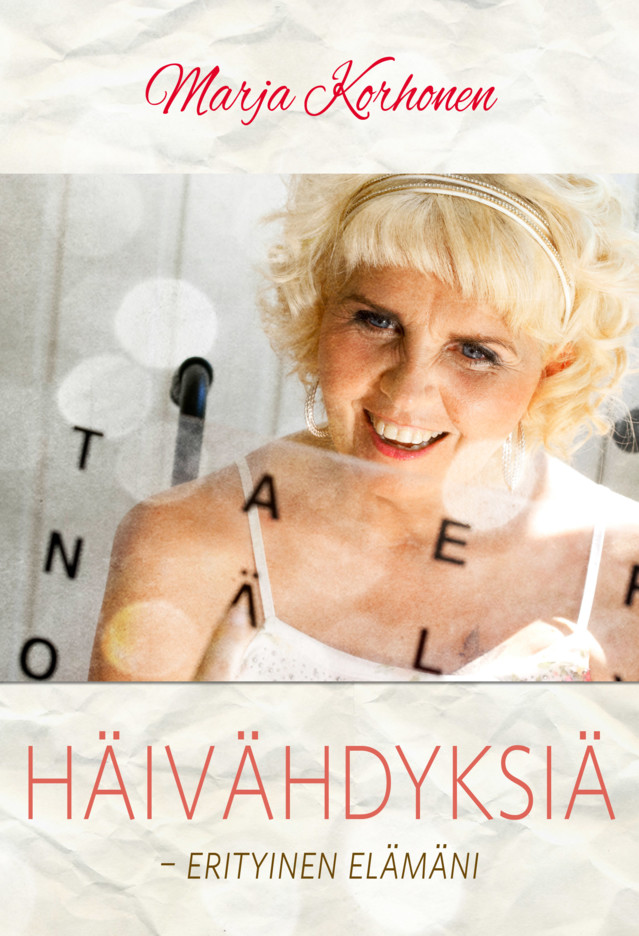Tarinaani on pyydetty jo kauan englanniksi:
AVH Magazine
December 2014
”I Fell In Love With Life”
Marja Korhonen is not able to talk or move. But she has a tiny chip, a computer mouse if you will, attached on her forehead, which she uses to write. And the writing is very fluent, from curse words to smileys.
Korhonen’s mind is as sharp as ever, and her attitude is as uncompromising as it used to be. The only thing that has changed a little bit is her idea about the most important thing in life. It’s love, even more than ever.
When Marja Korhonen woke up from coma, nobody needed to tell her about her condition. She knew, without telling. She couldn’t talk or move her arms and legs. Her emotions ranged from fear to rage.
“I felt like a vegetable, but deep inside me there was a tiger, ready to fight. I was so afraid I was going to die,” Korhonen writes in her book.
Korhonen’s book tells her story that began in the fall of 2004. She had a brainstem stroke, and malpractice caused her a condition known as locked-in syndrome. She was paralyzed from the neck down, and she had lost her ability to talk and swallow.
Korhonen spent weeks at the ICU, and has only reflections of that period of her life.
“I heard my loved ones were visiting me, but I didn’t want to look them in the eye. I didn’t want to see what was in their eyes. Unconsciously I was protecting myself. I couldn’t face those crushing feelings I had.”
She goes on to say that one thing that carried her through the hardest of times was the unconditional love of her family.
Faithful Delay In Care
One night in October of 2004, then 42-year-old teacher and a mother of three woke up with a terrible headache, and the other side of her body had no feeling. She waited till the morning and called her friend, who drove to the local hospital. They sent her to the regional hospital with a reference: suspected paralysis.
And then it was nothing but waiting. Korhonen’s condition got worse, but the attending doctor just decided they should see how her condition develops. This was in the afternoon.
During the night came the seizures, and Korhonen was transferred to the ICU. An MRI the following day told the hard truth; a clot in the brainstem area. A surgery was not an option, and dissolving the thrombosis had huge risks.
“Dissolving the thrombosis probably saved the only thing that still could be saved, my life,” Korhonen writes.
It was a touch and go situation for months, and all kind of medical treatments made Korhonen’s life sometimes too hard to handle. For example, nobody bothered to find out if she can feel pain. Which she sure did, like when different kind of feeding tubes were installed in her stomach.
Turning Head Made the Difference
By January next year, her inner optimist was back to take over.
“On my last day in the ICU I realized I can turn my head just a little bit to right. That’s when I knew I hadn’t lost the fight.”
As for the doctor who is responsible for delaying the proper care, her explanation was that the patient was young and perky, and that affected her diagnosis. And in her own opinion the doctor was also very busy and stressed out.
The first form of Korhonen’s communication was “one blink for yes, two blinks for no.” And once Korhonen got a computer and learned how to use the mouse, with her eyes, she was back in business.
Back Home, Finally
A year had gone by, and Korhonen felt she was ready to return home. She could live at home, have someone there to help her and attend different kind of rehab outside home, no problem. But there was a lot of convincing to do, after all, there was only one other person in Finland who has the same kind of condition and who is living at home, not in an assisted living center.
Korhonen drew a detailed plan; she would hire three assistants (later to be called Angels) to work daytime hours, a night crew of visiting nurses provided by her home town Saarijärvi would visit her twice every night, and her home would be remodeled and equipped with some safety features.
Her plan was approved, and she got the green light to move back home right before Christmas of 2005, and the move actually happened in 2006.
“I was so overwhelmed I cried. I had prayed for a miracle, and there it was,” she writes in her book.
And now she’s home and lives a full life, including attending different kind of therapies, like speech and physical therapies, giving speeches, visiting schools to talk against bullying, organizing charity events and travelling abroad. And she has relearned to swallow. No more tubes.
Yes, she may have lost her voice, but she is not speechless. She has her unique way to talk, like her whole life is unique; a Plexiglas with the alphabets and numbers printed on it. And how it works? Korhonen looks at a letter, her assistant clicks on it, and Korhonen blinks her eyes to confirm it’s the correct letter. This is how she makes words, letter by letter.
By Suvi Vainio

Kommentit